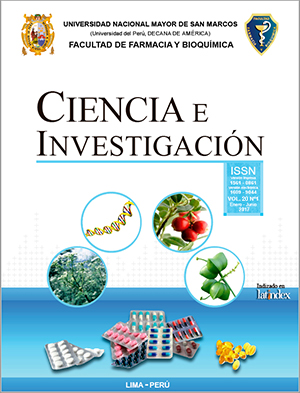Biofilm formation and resistance against two disinfectants in Listeria monocytogenes isolated sausages and surfaces
DOI:
https://doi.org/10.15381/ci.v20i1.14316Keywords:
Listeria monocytogenes, biofilm, disinfectantsAbstract
Listeria monocytogenes is a pathogenic microorganism capable of forming biofilms in the food production environment, being difficult to remove with normal cleaning and disinfection procedures. In the present study, was to evaluate the biofilm formation capacity of 20 strains of Listeria monocytogenes isolated from sausages and inert surfaces of a meat-processing plan. Detection of the bacteria was done using GeneQuence Test and the ability of biofilm formation was determined by the Djordjevic method at 620nm. Different temperatures conditions were evaluated: refrigeration (4 ºC), ambient (22 ºC) and 35 ºC, and it was obtained that 95% of the strains have the capacity to form biofilm for Stepanovic’s recommendations. The weak biofilm producing strains were 85% at 4 ºC and 35 ºC; however at 35 ºC 10% were moderate producer. Resistance to two disinfectants based on sodium hypochlorite and quaternary ammonium was evaluated in three contact times (5, 10 and 30 minutes), demonstrating that sodium hypochlorite is more efficient than quaternary ammonium to remove the biofilm from 30 minutes of exposure.Downloads
Published
2018-02-22
Issue
Section
Artículos Originales
License
Copyright (c) 2018 Nilda A. Castro, María E. Salazar

This work is licensed under a Creative Commons Attribution-NonCommercial-ShareAlike 4.0 International License.
LOS AUTORES RETIENEN SUS DERECHOS:
- Los autores retienen sus derechos de marca y patente, y tambien sobre cualquier proceso o procedimiento descrito en el artículo.
- Los autores retienen el derecho de compartir, copiar, distribuir, ejecutar y comunicar públicamente el articulo publicado en la Revista Ciencia e Investigación (por ejemplo, colocarlo en un repositorio institucional o publicarlo en un libro), con un reconocimiento de su publicación inicial en la Revista Ciencia e Investigación.
- Los autores retienen el derecho a hacer una posterior publicación de su trabajo, de utilizar el artículo o cualquier parte de aquel (por ejemplo: una compilación de sus trabajos, notas para conferencias, tesis, o para un libro), siempre que indiquen la fuente de publicación (autores del trabajo, revista, volumen, numero y fecha).
How to Cite
1.
Castro NA, Salazar ME. Biofilm formation and resistance against two disinfectants in Listeria monocytogenes isolated sausages and surfaces. Ciencia e investigación [Internet]. 2018 Feb. 22 [cited 2024 Jul. 17];20(1):15-20. Available from: https://revistasinvestigacion.unmsm.edu.pe/index.php/farma/article/view/14316













